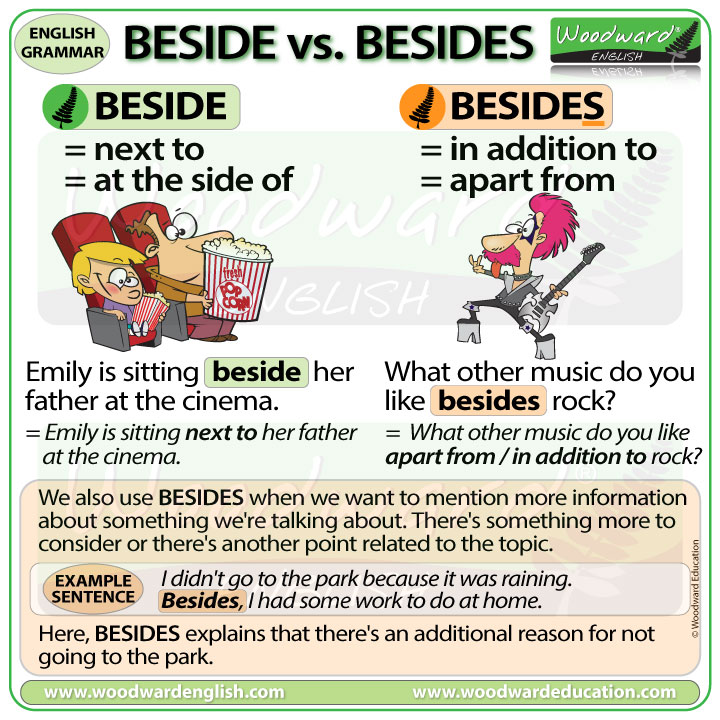What is the difference between BESIDE and BESIDES in English?
What does BESIDE mean?
BESIDE is a preposition of place that indicates a position next to or at the side of something or someone. The two things or people are side by side.
- Emily sat beside her father during the movie.
Here, Emily sat next to her father. There was no other person between them.
- Your keys are beside the lamp on that table over there.
Here we are giving the position of the keys, they are next to the lamp.
Note that using BESIDE sounds a little more formal than using NEXT TO.
Example sentences with BESIDE
- Please sit beside me at the table.
- The park bench is located beside the fountain.
- The cat curled up beside the fireplace to stay warm.
- The bakery is situated beside the grocery store.
- He stood beside his brother in the family portrait.
What does BESIDES mean?
BESIDES is an adverb or preposition that introduces additional information, introduces exceptions, or indicates something apart from what has been mentioned. Let’s look at this in a bit more detail.
BESIDES is useful when we want to mention more information or give extra details about something we’re talking about. It helps us show that there’s something more to consider or that there’s another point related to the topic.
Think of BESIDES as a way to say IN ADDITION TO or APART FROM. It’s like when you’re telling a story, and you want to say, ‘Oh, by the way, there’s something else interesting that happened.’ That’s when we use ‘besides.’
Examples:
Imagine you’re talking about your favorite sports. You might say:
- I love playing rugby. Besides that, I also enjoy swimming.
See how BESIDES lets you add additional information, another sport you like.
Or, if you’re discussing your talents, you could say:
- I’m good at drawing. Besides that, I’m also good at playing the piano.
Here, BESIDES helps you share another skill you have.
BESIDES can also be used when you’re giving reasons. For example:
- I didn’t go to the park because it was raining. Besides, I had some work to do at home.
In this case, BESIDES explains that there’s an additional reason for not going to the park.
BESIDES is a way to expand on what you’re saying and give a bit more information. It’s like a little extra detail that helps others understand you better.
Example sentences with BESIDES
- Besides studying for exams, she also has to prepare for the school play.
- I enjoy reading, and besides, it’s a great way to relax.
- The library offers a variety of resources, besides books.
- She’s skilled in painting and sculpture, besides being a talented musician.
- Besides being intelligent, he’s also incredibly kind and compassionate.
- What other music do you like besides rock?
Beside vs. Besides Grammar Chart

